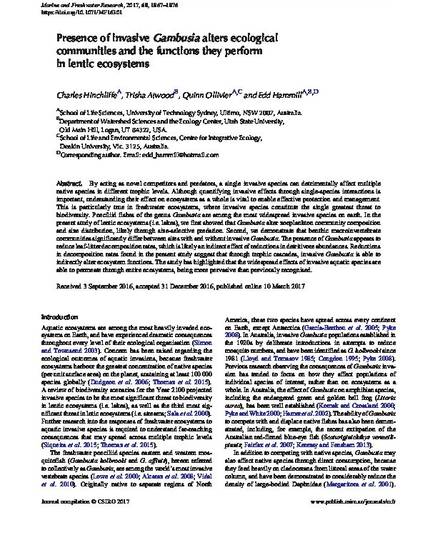
Article
Presence of invasive Gambusia alters ecological communities and the functions they perform in lentic ecosystems
Marine & Freshwater Research
(2017)
Abstract
By acting as novel competitors and predators, a single invasive species can detrimentally affect multiple native species in different trophic levels. Although quantifying invasive effects through single-species interactions is important, understanding their effect on ecosystems as a whole is vital to enable effective protection and management. This is particularly true in freshwater ecosystems, where invasive species constitute the single greatest threat to biodiversity. Poeciliid fishes of the genus Gambusia are among the most widespread invasive species on earth. In the present study of lentic ecosystems (i.e. lakes), we first showed that Gambusia alter zooplankton community composition and size distribution, likely through size-selective predation. Second, we demonstrate that benthic macroinvertebrate communities significantly differ between sites with and without invasive Gambusia. The presence of Gambusia appears to reduce leaf-litter decomposition rates, which is likely an indirect effect of reductions in detritivore abundances. Reductions in decomposition rates found in the present study suggest that through trophic cascades, invasive Gambusia is able to indirectly alter ecosystem functions. The study has highlighted that the widespread effects of invasive aquatic species are able to permeate through entire ecosystems, being more pervasive than previously recognised.
Disciplines
Publication Date
2017
DOI
https://doi.org/10.1071/MF16301
Citation Information
Edd Hammill. "Presence of invasive Gambusia alters ecological communities and the functions they perform in lentic ecosystems" Marine & Freshwater Research Vol. 68 Iss. 10 (2017) p. 1867 - 1876 Available at: http://works.bepress.com/edd-hammill/32/
